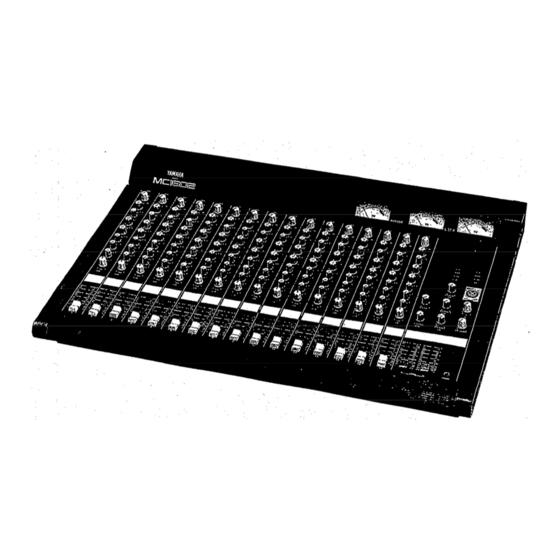
Yamaha mc-1202 Operating Manual
Mc series
Hide thumbs
Also See for mc-1202:
- Operating manual (16 pages) ,
- Service manual (7 pages) ,
- Operating manual (16 pages)
Advertisement
Table of Contents
Advertisement
Table of Contents

Summary of Contents for Yamaha mc-1202
- Page 1 ® YAMAHA AUTHORIZED PRODUCT MANUAL MC-Series Mixing Consoles...
- Page 2 YAMAHA MC-Series Mixing Consoles Operating Manual...
-
Page 3: Table Of Contents
Of course, the MC-series mixing consoles also offer the high standard of quality and great sound that Yamaha is famous for. We urge you to read this operation manual thoroughly in order to make the most of the mixer’s many features and controls. -
Page 4: Precautions
3. DO NOT OPEN THE UNIT OR ATTEMPT REPAIRS OR MODIFICATIONS YOURSELF This product contains no user-serviceable parts. Refer all maintenance to qualified Yamaha service personnel. Open- ing the unit and/or tampering with the internal circuitry will void the warranty. -
Page 5: Front Panel Controls
FRONT PANEL CONTROLS FRONT PANEL CONTROLS Input Channels PAD Switch This switch attenuates the signal applied to the corresponding rear-panel HI-Z or LO-Z input by 20 dB prior to the head amplifier and input gain control. The PAD switch effectively increases the range of input signal levels that can be handled by the mixer, preventing overloading of the input circuitry when receiving high-level signals. - Page 6 AUX 1 control to be rewired for pre-EQ/pre-fader operation. An internal POST EQ jumper allows the AUX controls to be further re-configured for post-EQ/pre-fader operation. REFER THE ABOVE-MENTIONED REWIRING JOBS TO QUALIFIED YAMAHA SER- VICE PERSONNEL! PAN Pots The PAN pot determines the position.
- Page 7 Channel Fader This is the main level control for each input channel. It determines the level of the signal sent from the corresponding input channel to the master stereo buss. The settings of the input channel faders determine the "mix" or balance of sound levels between the instruments or other sources connected to the inputs.
-
Page 8: Master Control Section
Master Control Section AUX SEND (1, 2 & 3) Controls & CUE Switches These adjust the overall output level of the auxiliary "mixes" set up using the AUX 1, AUX 2 and AUX 3 con- trols on the input channels. AUX SEND 1 sets the overall level of the AUX 1 mix signal appearing at the AUX SEND 1 jack, AUX SEND 2 sets the overall level of the AUX 2 mix signal appearing at the AUX SEND 2 jack,... - Page 9 Talkback ON Switch Pressing this switch activates the talkback microphone plugged into the talkback mic connector, allowing voice communication from the console operator to the STEREO, AUX 1, AUX 2 or AUX 3 busses according to the setting of the talkback assignment switches. TB (Talkback) Level Control Adjusts the level of the talkback signal sent to the selected buss.
- Page 10 VU Meters and METER Assign Switches (AUX1/AUX2/AUX3/CUE) The MC-series mixing console feature three VU meters with built-in LED peak indicators for monitoring signal levels. The rightmost meter pair (L ST R) continuously monitors signals on the main stereo program buss. The AUX/CUE meter can be switched to monitor signals on the AUX 1, AUX 2, AUX 3 or CUE busses by pressing the corresponding METER assign switch.
-
Page 11: Rear Panel Connectors And Controls
STEREO Master Faders The STEREO master faders independently adjust the level of the left and right channel main stereo program buss signals appearing at the STEREO OUT connectors. REAR PANEL CONNECTORS AND CONTROLS... - Page 12 POWER Switch Flip up to turn power ON, and down to turn power OFF. The VU meter lamps will light when the power is ON. PHANTOM MASTER Switch Turn this switch ON to apply +48 volts DC to the LO-Z XLR input connectors when using phantom-powered condenser microphones.
-
Page 13: Application Example
APPLICATION EXAMPLE In the system shown below the MC1602 is used as the main console in a sound reinforcement system. Three vocal micro- phones, six drum microphones, a microphone from the guitar amplifier and another from the bass amplifier are connected to 11 of the 16 available LO-Z inputs. -
Page 14: Block Diagram
BLOCK DIAGRAM... -
Page 15: Level Diagram
LEVEL DIAGRAM DIMENSION CHART... -
Page 16: Specifications
SPECIFICATIONS Total Harmonic Less than 0.1%, 20Hz – 20kHz @ +14dB Distortion into 600 ohms. Frequency Response +1, –3dB, 20Hz – 20kHz @ +4dB into 600 ohms –128dB Hum and Noise* (20Hz equivalent input noise. – 20kHz, Rs=150 ohms, –90dB residual output noise (balanced Input Gain max., Input outputs). -
Page 17: Input Characteristics
Input level required to produce rated +4dB output level. • 0dB = 0.775Vr.m.s. This product is supported by Yamaha’s worldwide network of factory trained and qualified dealer service personnel. In the event of a problem, contact your nearest Yamaha dealer. - Page 18 YAMAHA ® Yamaha Corporation of America 6600 Orangethorpe Avenue, P.O. Box 6600, Buena Park, CA 90622-6600 12/2/96...










Need help?
Do you have a question about the mc-1202 and is the answer not in the manual?
Questions and answers